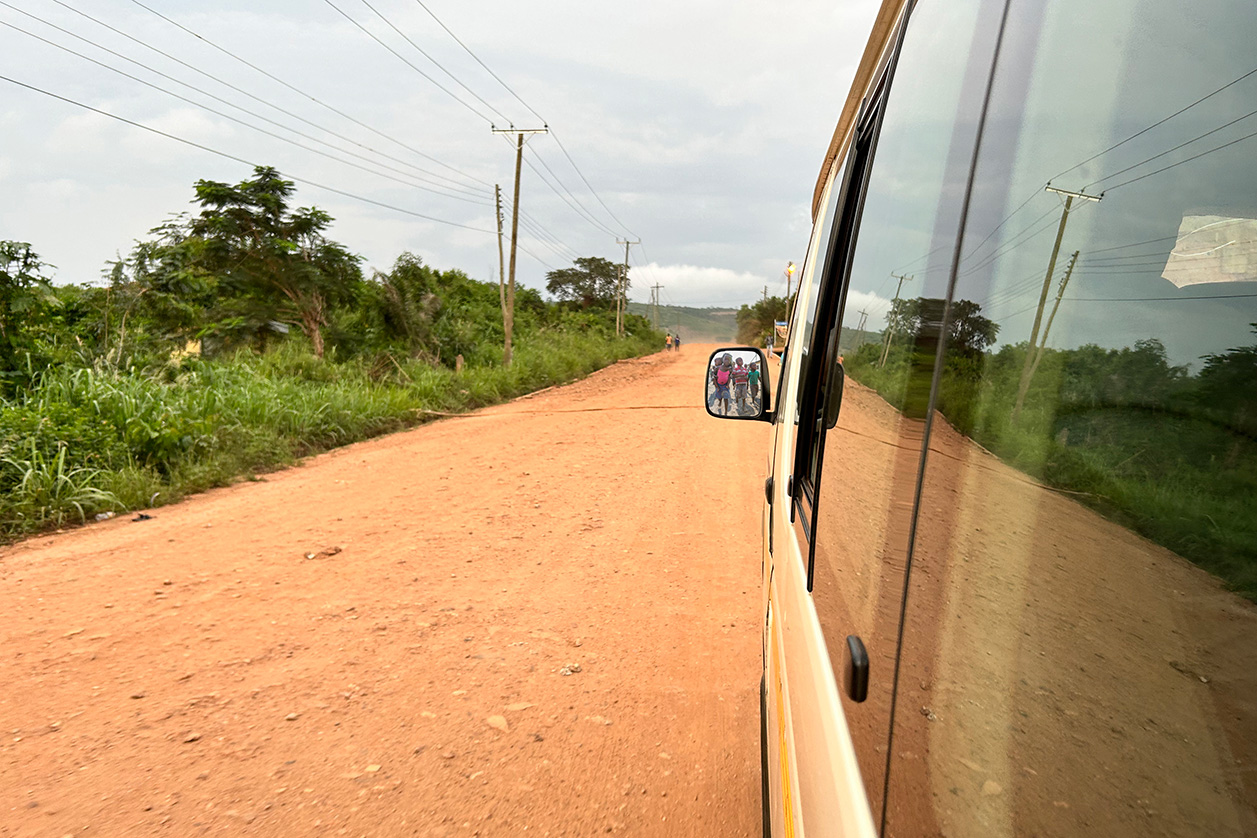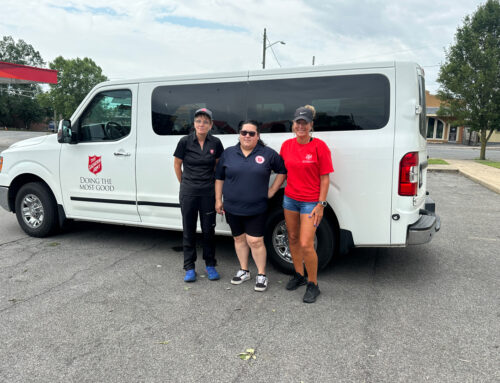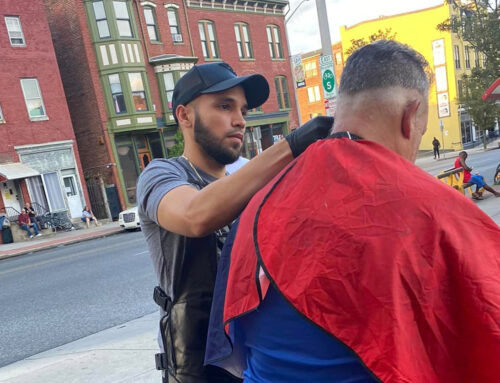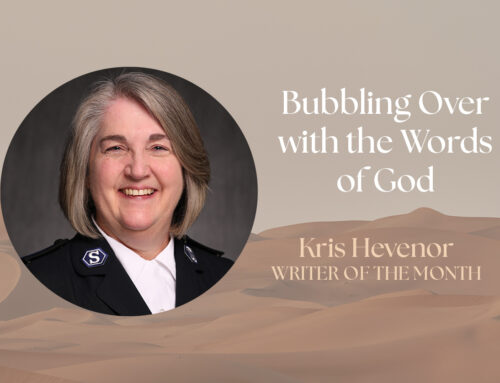
A different kind of poverty
by Robert Mitchell
“For I was hungry, and you gave me something to eat, I was thirsty and you gave me something to drink, I was a stranger and you invited me in, I needed clothes and you clothed me, I was sick and you looked after me, I was in prison and you came to visit me.”
—Matthew 25:35-36
After some 20 years in the news business, I thought of myself as a hardened journalist who had “seen it all.” That view of myself was severely shaken in 2006 when I accompanied a Salvation Army medical missions team to Honduras.
The truth is, I was naïve about how poor some people around the world are. Witnessing unimaginable poverty for the first time, I ended up with tears in my eyes more than once. It’s not an exaggeration to say that trip changed my life and the way I viewed the world.
One of those tear–jerking moments came when I saw an emaciated child whose arms and legs were the width of broomsticks. She was so weak, someone had to carry her to the clinic. As with many people who came to the clinic, she had a parasite infection from drinking contaminated water, doctors said, that essentially stole her food.
We saw people who were visiting a doctor for the first time in their lives. One woman, who was eight months pregnant, rode a bike for an hour to get to the clinic. Doctors were amazed she didn’t go into labor. One boy had a mosquito’s nest embedded in his head. His foot was also infected because, like many children there, he didn’t own shoes and walked barefoot on infested grounds and in contaminated streams.
I saw children who had little, but appreciated those simple things American kids take for granted. When I gave the Honduran children a tube of toothpaste, a coloring book, or even a small piece of candy, smiles lit up their faces. When I opened a bag of potato chips, I was surrounded by kids who begged for even one chip. The camera I wore around my neck was probably the most valuable item in some of the villages we visited.
A week later, I returned to the United States as a changed person. I had little sympathy when my teen–aged daughter complained that her outrageously expensive cell phone suddenly wasn’t good enough. My sons wanted new sneakers, which cost more than $100 a pair. They got tired of hearing about the children I befriended in Honduras as I reminded them to be content with what they had. When I walked into a grocery store—fully stocked with every food, drink, and convenience one could imagine—I thought about the friends I had met in Honduras. At that moment, I had to compose myself once again.
Over the years since that trip, I’ve become acutely aware that most people who have spent their lives in the United States have no idea how poverty around the world is affecting the lives of millions of people.

Despite living a challenging lifestyle, these children survive another day near Lusaka, the capital city of Zambia, Africa.
A global perspective
In 2022, the 14.4 percent of people living below the poverty line in this country, still have shelter, food, cars, cable television, video games, and even cell phones. The poverty guidelines from the U.S. Department of Health and Human Services were set at $13,590 ($37 a day) for a single person and $27,750 ($76 a day) for a family of four.
However, the global situation is far different. The World Bank says 9.2 percent of the population, or 689 million people, live below the international poverty line of $1.90 a day.
“If you know where you’re going to sleep tonight, and you have a roof over your head, and you have food in your refrigerator, and an extra set of clothes in your closet, you’re wealthier than 90 percent of the world,” says Connie Curilla, the U.S. administrator and historian for the Haitian American Friendship Foundation. “You’re in the top 10 percent of the wealthiest people in the world.”
For many years, Haiti has been ranked as the poorest country in the western hemisphere and has never fully recovered from a 2010 earthquake that killed 300,000 people.
“A lot of people do not eat every day and they certainly don’t eat three times a day,” Curilla said. “They feel pretty good about themselves if they have two or three outfits.”
The Salvation Army helps people around the world through its Overseas Child Sponsorship (OCS) and World Services Office (WSO).
Major Tracy Hughes, director of OCS in the USA Eastern Territory, said her office oversees programs that help at least 2,300 children under age 18 in 37 children’s homes, 14 schools, and 16 after–school programs in South Africa, Kenya, Zimbabwe, India, Pakistan, Myanmar, Indonesia, Malaysia, the Philippines, Jamaica, Panama, Honduras, Haiti, Brazil, Bolivia, and Mexico.
For many years, OCS supported individual children, but Hughes said that all changed in 2016 when The Salvation Army started helping specific centers through short–term projects.
“At some centers, we have three-year projects. I like that because it gives us a chance to connect with a center and stay with them and really see the progress,” Hughes said.
Just some of the current projects include a water tank in Kenya, a vehicle replacement in mountainous Brazil, along with funding for school uniforms, food, and education fees. In Pakistan, The Salvation Army helped provide new solar panels for the roof of the Shiloh Boys Home.
“It is so hot there and the only way they could afford to provide any kind of cooling for those boys was solar panels,” Hughes said.
Going green
Hughes said installing solar panels is part of a plan to make centers “more self–sustainable.”
“You’ll see that coming to the forefront more and more,” she said of solar energy. “If they can have a consistent method of electricity and cooling in the hot countries, that will be such a boon for them and will help them far into the future.”
In Latin America North, the Army formed a project that involves 12 after–school centers, which provide food, art supplies, and other needs.
“Sometimes even a small amount of money can do a great deal to fill in the gap,” Hughes said. “These after–school programs get kids off the street and away from sex traffickers and gangs. Some of these areas are dangerous.
“If kids belong somewhere, and someone notices when they’re missing, that’s a huge help.”
In Kenya West, The Salvation Army helped special–needs school officials buy a physical therapy table, wheelchairs, adaptive utensils, and other equipment. Last year, youth groups here in the U.S. East raised money for that project.
Hughes, who has led OCS since 2014, said 103 people and 27 groups (churches, Adult Rehabilitation Centers, women’s ministries, and family camps) regularly give money to OCS. Many hear of OCS through word of mouth or the internet and commit to $25 a month, though some give as much as $200 and “really take it to heart,” Hughes said.
Giving to OCS stayed strong during COVID–19 and the program raises $80,000 to $120,000 a year, Hughes said.
“Many of our supporters are long–term and have been giving for many years,” she said. “People tend to really have a place in their heart for children who need care. Once they hear the need in some of these countries, they’re hooked, like me. People are incredibly dedicated to this program, which always gives me hope.”

The Salvation Army uses solar panels to help lower utility costs in its centers worldwide, including the Shiloh Boys School in Pakistan.
Igniting spiritual fire
If someone feels led to give to a certain country, Hughes can accommodate their request. She said people’s “hearts are softened” through giving to OCS and when receiving the newsletter and photo updates about where their money is going.
“For some of them, their eyes are opened,” Hughes said. “Some people tell us they didn’t know about the needs in some of these places before they started giving and they were not aware of how some of these kids live.
“When a congregation starts to support a center, they start to see beyond their Salvation Army corps bubble. When they start to get some pictures of these kids and some stories of what they’ve gone through and what they’ve come out of … that can just light a corps on fire because that really is the mission of The Salvation Army—that every boy and girl would have a chance to live up to their God–given potential. That’s what we’re fighting for.”
For the kids on the receiving end of OCS funding, the money can truly be transformational, Hughes said.
“These children begin to see their value with people who love them and care for them and have goals for them and want to see them succeed,” Hughes said. “It can break some of the cycles that we see in some of these families of abuse and poverty. These simple centers—they’re places where kids can come and be safe.
“We have after–school programs here in the U.S. and know what they can do, and it’s even more so in other countries where resources are slim.”
Hughes has been around the world visiting summer missions teams in Kenya, Korea, Zambia, the Georgia Republic, Malaysia, and Honduras.
“They were all eye–opening in different ways,” she said. “I learned the human condition is tough everywhere.”
Shortly after becoming a Salvation Army officer, Hughes went to Uganda with Compassion International. When a woman stepped off a bus with her bag lunch and offered an apple to a little boy, a crowd of children suddenly emerged. “I don’t even know how to describe the desperation on their faces,” she said.
Raising awareness
For affluent Americans, the poverty around the world is tough to grasp. While some Americans struggle and live paycheck–to–paycheck, they live differently than people who are poor in other countries. Those people can frequently be seen scrounging for food in dumpsters, Hughes said.
“You see pictures on television, but unless you’re actually there and see for yourself, I think that’s really the only way to understand,” Hughes said. “I don’t think it’s possible to understand from a picture or television commercial or even a magazine layout. What must it be like to have your child dying in your arms from starvation or from a disease that has been eradicated in many other countries?”
Major Elmer Deming, who oversees the Eastern Territory’s WSO as stewardship engagement director, said, “In the internet age, it’s easier to learn about worldwide poverty.” However, he believes it still takes bold leadership from local Salvation Army officers to raise awareness.
“It starts with the corps officer,” Deming said. “You need to be sure that you’re supporting and living that example. I think the challenge with anything is, if people are not educated, if they’re not informed, it’s hard for them to relate or connect.
“It’s what God commands us to do in scripture for the ‘whosoever’ around the world.
“People within The Salvation Army know World Services exist, but we want to do a better job of promoting it.”
World Services supports 363 projects and about $12 million is set aside each year. Deming said the projects range from a few thousand dollars to $50,000.
“The U.S. dollar can obviously go far in some of these places because of the exchange rate,” he said.
Thinking globally
Deming’s office prepares promotional materials about ministry partners around the world, including Mexico, Zimbabwe, Zambia, India Central, and the Middle East. While OCS focuses on children, World Services is about the broader mission of The Salvation Army and involves outreach and corps programs.
“We have to have a global mindset,” he said.
“There are countries that are developing, and we are able to help them. Salvationists in those places are contributing to the improvement of their country.”
Among the recent projects in Mexico, The Salvation Army has constructed a building for deported refugee women and children; started a pilot daycare program; and built wells and cisterns for water.
Deming said the installation of solar panels helps to provide affordable energy to existing facilities. There also is new fencing and gating to protect congregants from gangs and traffickers, roofs to cover patio areas where children play under the sun, and emergency lamps at a children’s home.
Recent projects in Zimbabwe involve grants for farming and land purchases. Additionally, money was allocated for plumbing and roofing repairs and to replace concrete floors.
“We need to tell the story about the impact of these dollars and the difference between how we live, and the way other people live,” Deming said.
“In many places around the world, a dirt floor is the way of life. Yet they come to hear the word preached and they grow in faith.
“It’s mostly construction of buildings which helps The Salvation Army’s spiritual mission in that country,” Deming said.
Deming, a 33–year Salvation Army officer, has worked at the local corps level most of his career, but he appreciates the organization’s global footprint and hopes others do as well.
“The Salvation Army is bigger than your local corps,” he says. “God’s church is bigger than that. Gaining a global perspective has been a rewarding part of this position.
“It’s broadened my view of things and makes it more rewarding when I deny myself and make my contribution to World Services and self–denial. I know the impact it’s having and the difference it can make.”
Different challenges
In Zambia, The Salvation Army provides cattle that can be sold to help support the Chikankata Mission Hospital. World Services is also funding the construction of a clinic at the Syakalyabanyama school to help meet basic medical needs. Deming said the Army has also funded boreholes and ground tests for new centers and provided funding for title deeds and other legal documents.
In the Middle East, including Kuwait, Qatar, and the United Arab Emirates, The Salvation Army provided a van and maintains a Booth House to help fight human trafficking.
“Being an affluent area, it’s not about poverty, but more of a moral and ethical issue due to the treatment of people,” Deming said of the Middle East.
The projects in India Central include the construction of corps centers, “where people can gather for worship, for prayer, and for service.” This also includes building upgrades such as fencing, windows, doors, and other capital projects. For Deming, the projects help meet the scriptural demands of Matthew 28:18–20 and Mark 16:15 to take the gospel to all the world.

Families wait to be seen at the Chikankata Mission Hospital in Zambia.
Read more from the latest issue of SAconnects.




